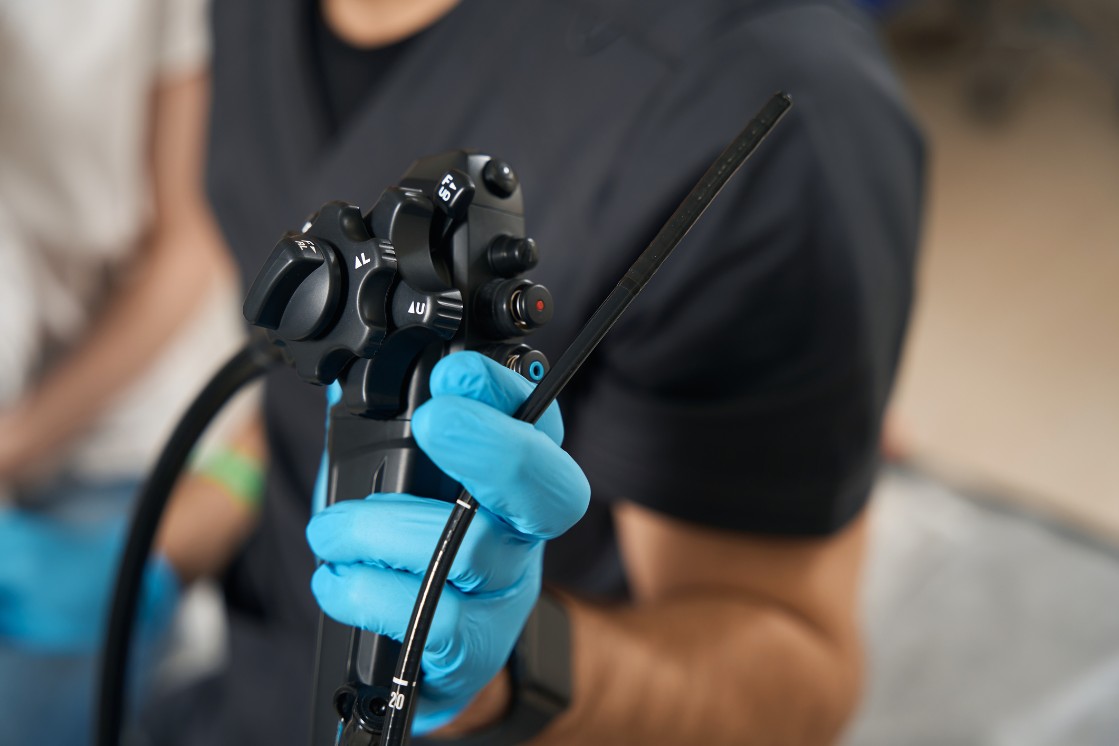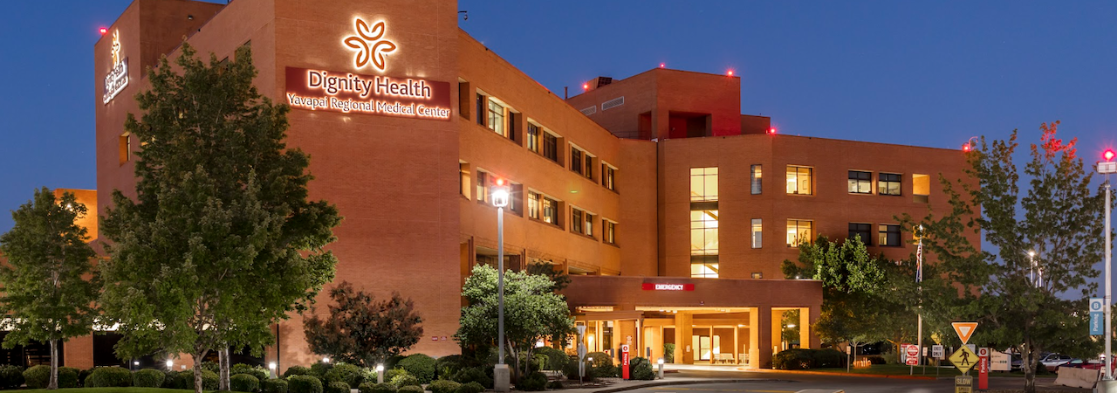Yavapai Regional Medical Center: Surgical Services

Advanced Surgical Expertise, Compassionate Care
When you choose Dignity Health Yavapai Regional Medical Center for your surgical needs, you're choosing a partner dedicated to your best outcome. We combine cutting-edge technology with deeply compassionate care, ensuring a seamless experience from consultation to recovery. Our state-of-the-art facilities and highly skilled team perform a comprehensive array of inpatient and outpatient procedures, including:
- Minimally Invasive: Faster recovery, less pain.
- Endoscopic: Precise internal examination and treatment.
- Arthroscopic: Advanced joint repair.
- Orthopedic: Specializing in bone and joint health.
- Diagnostic: Accurate evaluations for clear answers.
Minimally Invasive Robotic-Assisted Surgery
Yavapai Regional Medical Center is at the forefront of surgical innovation. Our highly skilled robotic surgeons and surgical teams are expertly trained to leverage the advanced precision of our state-of-the-art robot-assisted surgery system.
This cutting-edge technology offers significant advantages, guiding you toward a faster, more comfortable recovery. It provides surgeons with enhanced visualization and superior dexterity, allowing for incredibly precise movements and minimal impact on surrounding tissues. The result for you is often less pain, reduced blood loss, and a quicker return to your daily activities.
Key Benefits of Robot-Assisted Surgery:
- Minimized Incisions: Leads to smaller scars, reduced pain, and less tissue damage.
- Enhanced Precision: Surgeons can perform delicate procedures with greater accuracy and control, protecting surrounding healthy tissue.
- Reduced Post-Operative Pain: Often lowers the need for pain medication after surgery.
- Accelerated Recovery: Typically means a shorter hospital stay and a faster return to your normal life.
- Less Scarring: Enables you to focus on healing, not visible marks.
- Lowered Risk of Complications: Compared to traditional open surgery, there's often a reduced risk of infection and other complications.
Endoscopic Procedures
Endoscopic procedures provide a way for physicians to examine and access internal organs. This involves gently inserting a long, thin, flexible tube, known as an endoscope, into the body.
The endoscope is equipped with a camera and light, allowing doctors to visualize structures, diagnose conditions, and, in many cases, perform therapeutic interventions directly, often without the need for traditional open surgery. Entry points typically include natural body openings like the mouth, nose, rectum, or a small incision.

Endoscopy Services
-
Colonoscopy
Colonoscopy is a minimally invasive procedure that allows your doctor to examine the inside of your large intestine (colon) for early signs of disease, including cancer. A thin, flexible tube with a small camera is gently guided through the colon, providing a detailed view. Colonoscopies are used to:
Screen for colon cancer, allowing for early detection and treatment.
Perform biopsies to diagnose various conditions.
Remove polyps and other abnormal tissue, preventing potential problems.
Look for signs of intestinal conditions, such as inflammation or bleeding.
Place stents to keep the colon open, if necessary.
-
Endoscopic Banding
Endobronchial Ultrasound (EBUS) is a minimally invasive diagnostic procedure used to evaluate conditions within the lungs and airways. During an EBUS procedure, a slender, flexible tube, equipped with both a miniature video camera and an ultrasound probe, is carefully guided by a physician through the pathways of the windpipe and into the lungs.
This technology allows for detailed visualization and assessment of lung tissue and surrounding lymph nodes. EBUS is highly valuable in identifying the underlying causes of lung inflammation and infections, and it plays an important role in the diagnosis and staging of lung cancer.
-
Percutaneous Endoscopic Gastrostomy (PEG)
Percutaneous Endoscopic Gastrostomy (PEG) is a medical procedure that establishes a pathway for nutritional support directly into the stomach. It is utilized for patients unable to consume adequate food or liquids orally.
During the procedure, an endoscope – a flexible tube equipped with a camera – is guided into the stomach. This allows for precise placement of a feeding tube, which is then secured through a small incision in the abdominal wall. PEG is commonly considered for individuals requiring long-term enteral feeding, typically for durations of four months or more.
-
Endobronchial Ultrasound Bronchoscopy (EBUS)
EBUS utilizes advanced technology to provide a minimally invasive way to diagnose lung conditions.
This procedure combines a slender, flexible tube with a miniature video camera and an ultrasound probe, allowing physicians to visualize the airways and lungs and identify the causes of inflammation, infections, and even detect lung cancer.
-
Upper Gastrointestinal (GI) Endoscopy
An upper GI endoscopy is a diagnostic and therapeutic procedure employed to evaluate conditions of the esophagus, stomach, and duodenum (the initial segment of the small intestine).
During the procedure, a flexible tube fitted with a camera is precisely guided into these organs. This enables the physician to visualize the internal lining, obtain tissue samples (biopsies), manage bleeding, inject fluids, and perform other targeted interventions as required.
Inpatient Surgery
Understanding your surgical recovery options is key. If your surgeon schedules inpatient surgery at Yavapai Regional Medical Center, you will remain in the hospital for at least one night to ensure comprehensive post-operative care. Prior to your inpatient procedure, a member of our surgical admissions team will call to collect your patient medical history and offer vital pre-operative guidance.
Regardless of whether you choose outpatient or inpatient surgery, your initial recovery period occurs in our state-of-the-art Post Anesthesia Care Unit. Here, our expert nurses diligently monitor your vital signs, meticulously check your surgical incision site, and proactively manage any post-surgical discomfort. Upon achieving appropriate anesthesia recovery, you will be transferred to your assigned room for continued healing before your hospital discharge.
Outpatient Surgery
Outpatient surgery, also known as same-day surgery, allows patients to return home the very same day, eliminating the need for an overnight hospital stay. The suitability of an operation for outpatient procedure depends on factors like surgical complexity and potential for post-operative complications. Your physician or surgical specialist will carefully consider your age, medical history, and overall health status when determining if same-day surgery is appropriate for your specific condition.
A significant advantage of outpatient surgical recovery is the ability to heal in the familiar comfort of your own home. While you may feel well enough for hospital discharge, it's crucial to understand that you'll require assistance. For the initial 24 hours following your outpatient procedure, you must arrange for a trusted friend or family member to transport you home and provide essential post-operative care and supervision.

What to Expect on Your Surgery Day
To ensure a smooth and comfortable experience on your surgery day, understanding the admission process and pre-operative preparations is key. Here's a guide to what you can expect upon arrival for your surgical procedure.
Upon your arrival at Yavapai Regional Medical Center for surgery admission, please check in with our Admitting Department. To ensure a smooth check-in process, remember to bring your photo identification, insurance card, and preferred payment method. Our team will have a customized patient information packet ready, pre-filled with details you and your doctor have provided, along with necessary surgical consent forms for your signature. At this point, you will receive your hospital identification bracelets and be guided to the surgery waiting room.
To facilitate your pre-surgery preparations, you will undergo a series of essential procedures: Our nursing staff will accurately measure your pre-operative vital signs, including blood pressure, pulse, respirations, temperature, and oxygen saturation levels, ensuring you are ready for your surgical procedure.
For women of childbearing age, a urine specimen is required as part of our pre-operative assessment. If immediate restroom use is needed, please obtain a specimen container from Admitting first. For your comfort and security, we highly recommend leaving valuables and non-essential items at home. Any remaining personal belongings should be checked in or entrusted to your designated support person before entering the pre-operative area.
If you typically use hearing aids or eyeglasses, you may keep them with you until just before entering the operating room; at that point, please transfer them to your family or friend for safekeeping. You will change into a comfortable hospital gown and slippers. For safety reasons, please do not wear undergarments. A convenient plastic bag will be provided for your clothing. To ensure clear identification without disclosing surgical order, you will be assisted onto a stretcher with warm blankets and assigned a unique patient identification number visible at the front of your stretcher.
A registered nurse will establish your intravenous (IV) line and thoroughly explain the expectations for your hospital stay or same-day surgery recovery. For your safety and to comply with surgical safety protocols, your surgeon or the operating room staff will mark the specific surgical site on your body. Your family members or friends are welcome to remain with you in the pre-operative area until it is time for your surgical procedure
Experiencing surgery can be a trying time for families. At Yavapai Regional Medical Center, we prioritize family communication during surgery with a transparent patient tracking system.
When you reach the pre-surgery area, your family receives a confidential PIN and your surgeon's contact information. This PIN enables them to monitor your surgical progress via a tracking board in the surgery waiting room, showing your location: pre-op, operating room, or recovery room, or if moved to a private room. For extended surgeries (over an hour), an OR nurse will call the waiting area at 60 minutes for a personal status update.
Once you're in the operating room, family can use the surgical waiting room. Your surgery duration depends on the procedure, with your surgeon providing an estimate. Our waiting area offers amenities like TV and magazines. We advise family to remain present immediately post-surgery to ensure communication with the surgeon.
Following your surgery, you will transition to our Post Anesthesia Care Unit (PACU). Here, our specialized team manages your recovery from anesthesia (general, local, or regional). Most patients spend between 30 to 90 minutes in PACU, depending on anesthesia type and individual recovery speed. While you may feel in and out of consciousness, this is a normal part of the anesthesia recovery process.
Comprehensive Monitoring in PACU Our rapid recovery care includes:
- Vital sign monitoring (e.g., blood pressure, oxygen levels).
- Pain and nausea assessment, with quick medication administration.
- Surgical site observation.
- Executing all post-surgical orders.
- Offering ice chips for comfort.
Managing Post-Surgical Pain Pain management after surgery is a priority. Your PACU nurse will accurately assess your pain using a patient-reported scale and administer appropriate pain relief medication. Your input is vital for effective pain control.
PACU Visitor Policy For patient safety and privacy (HIPAA compliant), family visitation is restricted in PACU. We will reunite patients with their loved ones upon readiness for hospital discharge or transfer to their inpatient room.
Healing Strong: Your Post-Surgery Guide
Your successful recovery is our priority. As you transition home after surgery, we're here to support you every step of the way. This comprehensive resource provides invaluable advice on managing discomfort, promoting healing, and recognizing important signs as you regain strength and vitality.
Let's work together to make your post-surgical journey as comfortable and effective as possible.

Learn More About Inpatient and Outpatient Surgery At Yavapai Regional
Should you have any specific questions or concerns about your planned inpatient or outpatient procedure, our dedicated team is available to assist you.
Yavapai Regional Medical Surgery Locations


